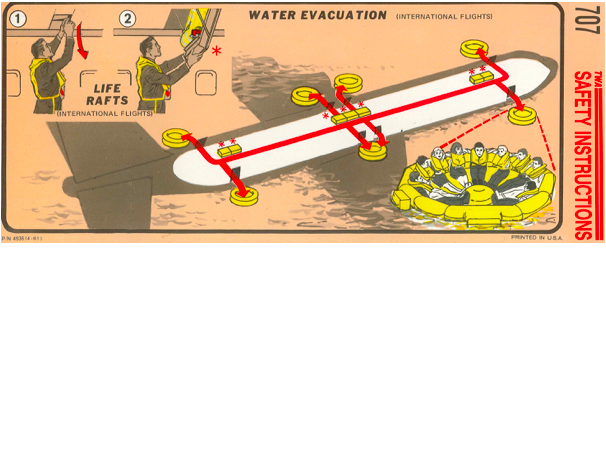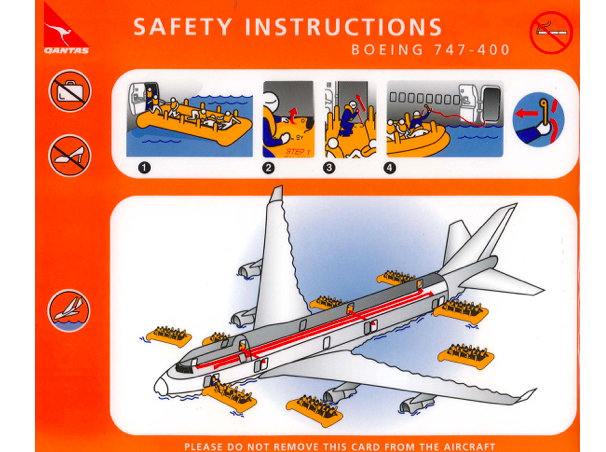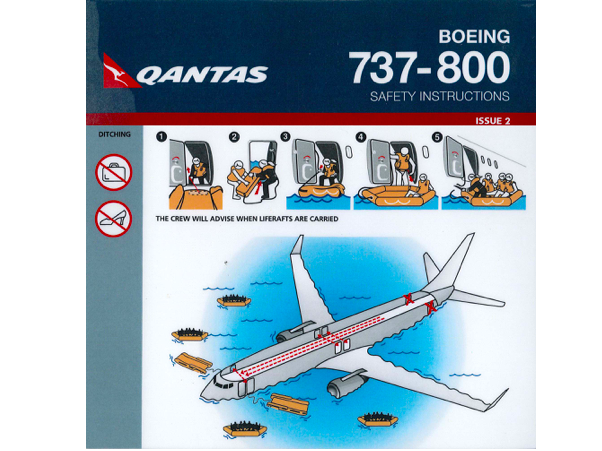It's the well-known ritual before the plane takes off. During the safety demonstration the crew refer to the safety instructions in the back of the seat in front, and that card contains information about an Australian invention that was to become essential to safety in the event of a crash at sea.
Small planes, such as those used by regional airline REX (with the world’s largest fleet of the SAAB 340) have internal folding stairs that connects the plane to the ground, which can also be used in the case of an accident. However larger jet planes are so high off the ground that an integral pneumatic slide was introduced as a means to reach the ground, or sea.
Early jet planes had life rafts stored in overhead locations, which could be taken down by passengers or crew, and launched through the door in the event of a crash on water. This form of cumbersome life-raft can be seen in this safety card from a Boeing 707 operated by the USA airline TWA in the mid 60’s. If there was an emergency landing at sea, this was the way to ensure passenger safety.

In 1965 Jack Grant, Qantas operations safety superintendent, thought up a better idea: to combine the escape slide and the life raft into one inflatable item. When launched in a crash on water, people could slide down, stay on the slide, release it from the aircraft, and the slide became the life-raft.
Jack Grant put the proposal before aircraft manufacturers in the United States and Britain, who required tests on its performance and safety. Sea trials were held in a number of locations including Barbados, Honolulu, and Sydney. Grant then demonstrated the idea to airline operators and government agencies, manufacturers, and survival equipment experts of many countries.
Working through the International Air Transport Association (IATA), Grant formulated and refined the specification of the slide raft until it was accepted by the all key organisations including the United States Federal Aviation Administration and the British Air Registration Board.
This picture shows Jack Grant on his combination slide-raft in the Qantas crew training centre in Sydney in the late 60’s.

The invention was just in time for the launch of the Boeing 747 ‘Jumbo’, a plane that was to revolutionize international travel, and one celebrated by Sir Norman Foster as his choice as the greatest ever building design. Here is the slide explained and demonstrated on a safety card from a Qantas 747 plane:

From that time onwards, the slide-raft was fitted to all the large jet aircraft: Boeing, Airbus, Douglas DC1, Lockheed 1011 and eventually the magnificent Concorde. All had escape slides that could be detached from the aircraft and passengers could float away from the distressed aircraft in safety.
Here is a safety card from an early Airbus A300 operated by TAA (Trans Australia Airways), later absorbed into Qantas. (On a side note: the airy TAA terminal at Sydney Airport, designed by Don Gazzard, was one of our finest modernist buildings, now demolished, of course.)

Jack Grant’s slide-raft went on to win the Cumberland trophy, a safety award from the Guild of Air Pilots and Navigators for an outstanding contribution to air safety.
Now turning to the mixed quality of graphics demonstrating Jack Grant's invention. Despite a large number of artists in Australia being able to depict water effectively and beautifully, Qantas struggled to get the graphics right on some of their safety cards.

Qantas later improved the graphics as seen on this later safety card:

Some airlines adopted the KISS principal: Keep IT Simple Sweetheart (aka Stupid):

Some safety cards, such as these versions from Alaska Airlines, JetBlue and Kuwait Airlines give an excellent explanation of how the slide works, but it is doubtful the detailed and complex graphics could be read quickly in the event of an emergency. Can a passenger spend an half an hour trying to figure out what's going on before exiting the plane?

The quality of the graphics varies in these examples. In the event of a crash, it's unlikely that anyone is referring to these cards, rather relying on the crew to direct passengers to safety.
Finally, there are some that area simple and direct and inform exactly what is happening. WAMOS, the Spanish airline, has a beautifully simple graphic that eliminates the excess information.
Jack Grant should be forever remembered for the invention of the slide-raft; it was featured in the movie Sully: Miracle on the Hudson, starring Tom hanks as the hero pilot Chelsey Sullenberger.

